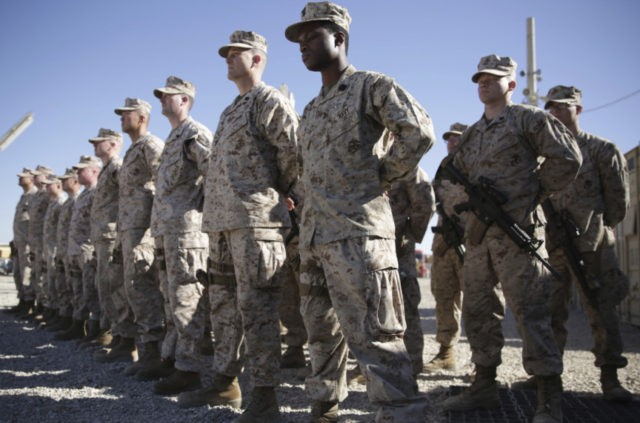The U.S. Department of Defense (DOD) over the weekend identified the two American soldiers killed on Saturday by an alleged “Taliban insider” donning an Afghan military uniform as the United States and the narco-jihadi group continue peace negotiations to end the more than 17-year-old war in Afghanistan.
On Saturday, the Pentagon revealed:
Spc. Joseph P. Collette, 29, of Lancaster, Ohio. Collette was assigned to the 242nd Ordnance Battalion, 71st Explosive Ordnance Disposal [EOD) Group, Fort Carson, Colorado.
Sgt. 1st Class Will D. Lindsay, 33, of Cortez, Colorado. Lindsay was assigned to 2nd Battalion, 10th Special Forces Group (Airborne), Fort Carson, Colorado.
“Both soldiers died March 22, 2019, in Kunduz Province, Afghanistan, as a result of wounds sustained while engaged in combat operations,” DOD noted.
“The incident is under investigation,” it continued, without elaborating further.
Citing Afghan officials on the day of the incident, the New York Times (NYT) reported that a “Taliban insider” in Afghan National Defense and Security Forces (ANDSF) attire “deliberately provoked the attack” by opening fire from a security checkpoint on the late U.S. Green Beret, EOD tech, and their Afghan special forces counterparts around 3 a.m. on Saturday as they
The incident triggered a firefight between U.S. troops and Afghan soldiers stationed at the nearby outpost the Times learned from Mohammed Ibrahim, the commander of Afghan Local Police in Kunduz Province, “who described it as an accident set off by the insider who first opened fire.” ANDSF troops include military and police units.
“The combined Afghan and coalition ground force was fired on by an unknown assailant at close range from the checkpoint as well as from two other directions,” Sgt. 1st Class Debra Richardson, a spokeswoman for the U.S. military in Afghanistan told the Times. “The fire from the enemy was indiscriminate and came from multiple directions.”
NYT found that a subsequent U.S. airstrike in the Kunduz city region killed at least 14 civilians, including women and children, as well as four Afghan soldiers. The possible friendly fire incident came about 10 days after a misunderstanding resulted in Afghan service members opening on a patrol of their counterparts and American advisers in southern Afghanistan’s Uruzgan province, triggering a battle and U.S. airstrikes that killed at least five Afghan soldiers and injured nine others.
“We are fighting in a complex environment and this firefight is a prime example of the challenges Afghan and coalition forces face every day,” Sgt. Richardson told NYT on Saturday. “The Taliban were hiding in civilian homes and maneuvered in and out of compounds without any concern for the families living inside.”
“We maintain the right to engage the enemy in self-defense and we take every measure to prevent civilian casualties, even as the Taliban intentionally hide behind women and children,” she added.
On Friday, Voice of America (VOA) reported that two U.S. Army soldiers and an Afghan partner in Kunduz were killed in “joint counter-Taliban operation,” without mentioning anything about an insider attack.
A spokesman for the Taliban reportedly acknowledged that the clash took place in territory held by the terrorist group around Kunduz city, the capital of a volatile province of the same name.
The two recent deaths bring the total number of American military fatalities in the ongoing Afghanistan war to 2,280, according to Pentagon figures. There have also been 20,434 maiming incidents since the conflict began in October 2001. Several U.S. government and independent assessments have deemed the Afghan Taliban the top perpetrator of casualties sustained by the United States and local forces and civilians.
So far this year, four American service members have paid the ultimate sacrifice in Afghanistan. An additional 13 U.S. troops were reportedly killed in combat operations in Afghanistan last year, a slight increase from 11 in 2017.
The vast majority of U.S. military fatalities (74 percent) and injuries (86 percent) took place under former American President Barack Obama’s watch: 1,689 dead and 17,535 wounded.
U.S. President Donald Trump inherited chaotic security conditions from his predecessors — primarily a Taliban emboldened by unprecedented power and influence.
In recent months, the Trump administration has intensified its Taliban peace-seeking efforts to end the conflict, which has come at a cost to American taxpayers of an estimated $3 billion monthly.
Amid the ongoing U.S.-Taliban negotiations to convince the terrorist group to engage in peace talks with the Kabul government, the narco-jihadis have intensified attacks against American troops as well as Afghan forces and civilians.
The terrorist group has managed to make small territorial gains during the peace negotiations, which so far have yielded two draft agreements on the eventual U.S. military withdrawal and assurances by the Taliban that Afghanistan will no longer harbor international terrorist groups like al-Qaeda and the Islamic State (ISIS/ISIL) — both currently active in the country.
Taliban terrorists still refuse to allow Afghan President Ashraf Ghani’s administration to participate in the talks despite America’s insistence that the negotiations are Kabul led and owned.
In 2015, the Taliban briefly occupied Kunduz city, marking the first provincial capital to fall to the narco-jihadis since American troops removed the terrorist group’s regime from power soon after invading Afghanistan in late 2001. Taliban jihadis overran the city again the following year and have maintained a heavy presence in and around Kunduz city since.
Pentagon officials reportedly offered to pull the U.S. military troops out of Afghanistan within three to five years, acknowledging that it is essential to leave behind a residual counterterrorism force to ensure the Taliban keeps its promises. However, the terrorist group rejected the offer.
Taliban jihadis have long said they will negotiate with Kabul after the complete withdrawal of foreign forces.
According to the latest U.S. government assessment, the Taliban holds more territory and influence now than during any other time since U.S. troops removed its regime from power soon after invading the country in late 2001.

COMMENTS
Please let us know if you're having issues with commenting.